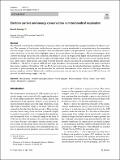Files in this item
Electron carriers and energy conservation in mitochondrial respiration
Item metadata
| dc.contributor.author | Ramsay, Rona R. | |
| dc.date.accessioned | 2019-05-01T08:30:02Z | |
| dc.date.available | 2019-05-01T08:30:02Z | |
| dc.date.issued | 2019-06 | |
| dc.identifier | 258517949 | |
| dc.identifier | c273c657-4eb6-436c-8fde-16d79997098a | |
| dc.identifier | 000465576500002 | |
| dc.identifier | 85069997447 | |
| dc.identifier.citation | Ramsay , R R 2019 , ' Electron carriers and energy conservation in mitochondrial respiration ' , ChemTexts , vol. 5 , 9 . https://doi.org/10.1007/s40828-019-0085-4 | en |
| dc.identifier.issn | 2199-3793 | |
| dc.identifier.other | ORCID: /0000-0003-1535-4904/work/56861226 | |
| dc.identifier.uri | https://hdl.handle.net/10023/17620 | |
| dc.description.abstract | The chemical system for the transformation of energy in eukaryotic mitochondria has engaged researchers for almost a century. This summary of four lectures on the electron transport system in mitochondria is an introduction to the mammalian electron transport chain for those unfamiliar with mitochondrial oxidative phosphorylation. It gives references chosen to reflect the history of the field and to highlight some of the recent advances in bioenergetics. The electron transport chain converts the energy that is released as electrons are passed to carriers of progressively higher redox potential into a proton gradient across the membrane that drives adenosine triphosphate (ATP) synthesis. The electron carriers include flavins, iron–sulfur centers, heme groups, and copper to divide the redox change from reduced nicotinamide adenine dinucleotide (NADH) at −320 mV to oxygen at +800 mV into steps that allow conversion and conservation of the energy released in three major complexes (Complexes I, III, and IV) by moving protons across the mitochondrial inner membrane. The three processes of proton pumping are now known after the successful determination of the structures of the large membrane protein complexes involved. Mitochondria and their proteins play roles not only in the production of ATP but also in cell survival, for which energy supply is the key. | |
| dc.format.extent | 14 | |
| dc.format.extent | 3294203 | |
| dc.language.iso | eng | |
| dc.relation.ispartof | ChemTexts | en |
| dc.subject | Mitochondria | en |
| dc.subject | Oxidative phosphorylation | en |
| dc.subject | Proton gradient | en |
| dc.subject | Redox potential | en |
| dc.subject | Flavin | en |
| dc.subject | Heme | en |
| dc.subject | Iron-sulfur cluster | en |
| dc.subject | Respiratory complexes | en |
| dc.subject | QD Chemistry | en |
| dc.subject | QH301 Biology | en |
| dc.subject | T-NDAS | en |
| dc.subject | SDG 7 - Affordable and Clean Energy | en |
| dc.subject.lcc | QD | en |
| dc.subject.lcc | QH301 | en |
| dc.title | Electron carriers and energy conservation in mitochondrial respiration | en |
| dc.type | Journal article | en |
| dc.contributor.institution | University of St Andrews. Biomedical Sciences Research Complex | en |
| dc.contributor.institution | University of St Andrews. School of Biology | en |
| dc.identifier.doi | https://doi.org/10.1007/s40828-019-0085-4 | |
| dc.description.status | Peer reviewed | en |
This item appears in the following Collection(s)
Items in the St Andrews Research Repository are protected by copyright, with all rights reserved, unless otherwise indicated.

